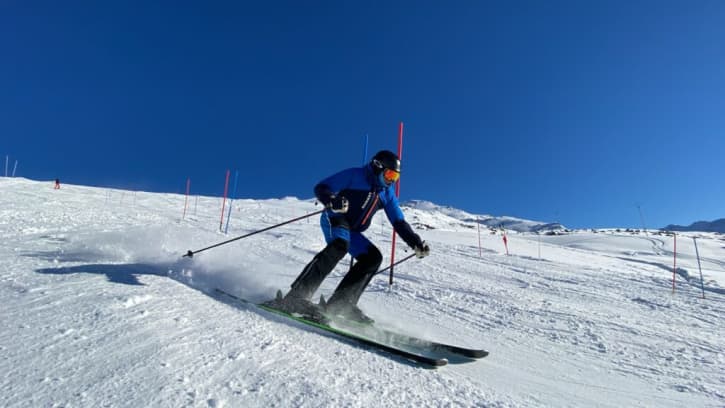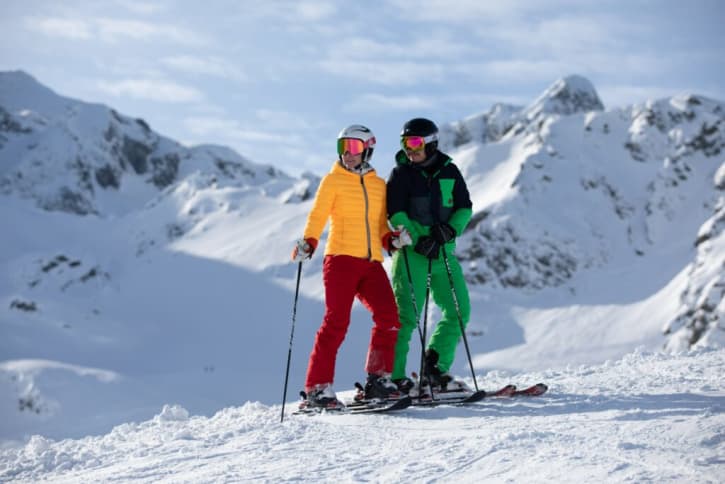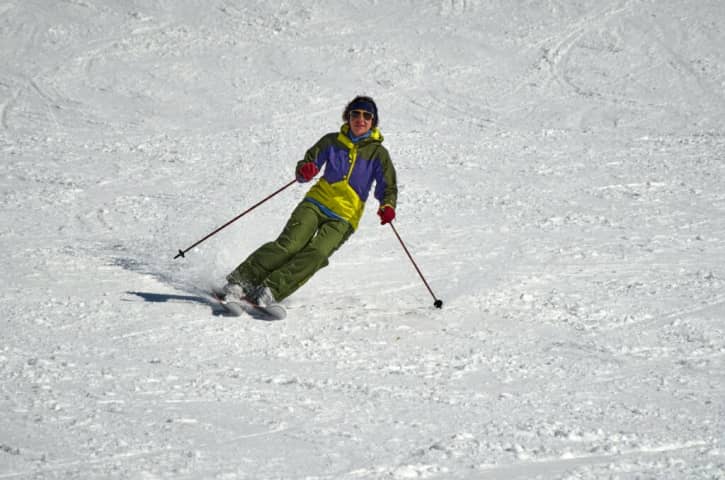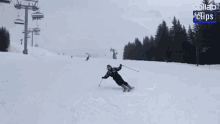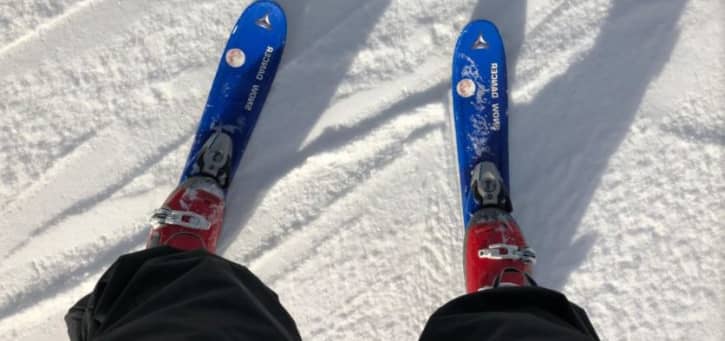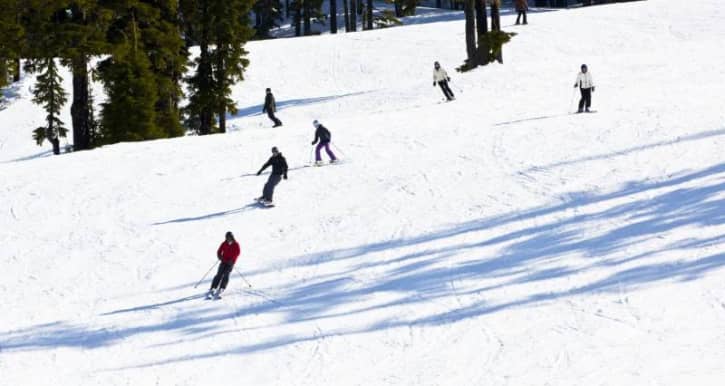Buying skis for the first time? Your beginner skis will be your most loyal companions during the season and will lead you on many adventures. But buying snow skis can be confusing because there are many types of skis. This guide will help make sense of their different materials and features, and how to find the best size and length for you.
Contents
Identify Your Skiing Style
Your first step is to decide what you want out of your skiing experience. So you need to answer: “What type of skiing do I want to learn?”
There are several types of skis designed for different types of skiing such as powder and all mountain skis. Powder and all-mountain snow skis are just two of the many varieties available. Each variety has its own distinct features to serve distinct purposes.
You can select skis that help you go faster, or ones that keep you from sinking into deep powder. Beginners should buy skis that are suitable for an average ski slope.
Buying vs. Renting
The next question to ask yourself is: “How much am I going to be skiing?”
Don’t commit a lot of time and money if you’re just going on a single ski trip. It’s okay if your beginner skis don’t last a long time.
Actually, you should consider renting skis on the mountain or a nearby ski shop if you don’t get to go skiing very often. (Pro tip: Call the ski rental place ahead of time to reserve your skis. On our last ski trip to Colorado over Spring Break, most ski rental shops were plumb out!)
Read also: Buying Skis vs. Renting (The Complete Cost Breakdown)
Ski Shape
The shape of skis you select depends on the style of skiing and the type of terrain. However, with the help of new ski technology, there are endless ski shape combinations. Here is some essential vocabulary that every beginner needs.
| Term | Definition |
| Rocker | This is the curved rise of the ski tail.
Its main purpose is to lift the ski out of the snow. If a ski has more rocker, this means that it can lift out of the snow and turn more smoothly. If a ski doesn’t have much rocker, it’s difficult to turn and lift on soft snow. The main types of the ski rocker are camber, rocker, and flat. |
| Sidecut | It’s the inner curve in the middle of the ski.
This is what gives some skis more of an hourglass shape. It is normally measured in radius (in meters), like the ski is one small segment in a gigantic circle. The size of the sidecut will determine your speed and how you’ll turn. A deep sidecut will make you turn more tightly, but they’re less stable when skiing at a fast speed. A less deep sidecut makes the skis float on the snow and makes the skis do long S turns. |
| Camber | It’s the upward curve in the middle of the ski.
The size of the camber has an impact on weight distribution. In fact, when you step on the skis, this curve will become flat and touch the snow when you make a turn. There is a plethora of camber profiles designed for different skiing styles. A longer camber is when the contact points are spread out to each end of the ski. That allows you to have effective edges and be more precise when turning on groomed or hard-packed snow. Similarly, a camber provides grip and stability on hard snow. At the end of a turn, the camber propels the skier to the next turn. |
| Flat | This means that the ski or snowboard has the same level when laid on a table. There is no curve in the middle.
This feature is more commonly seen on snowboards, as this helps riders maneuver and turn better. |
| Waist Width | This simply means the width of the narrowest section of the ski.
The width you choose will depend on the skiing style and terrain. A waist width of 70-90mm is good for groomed slopes, while a waist width of more than 90mm will give excellent results on deep snow. |
What Size Skis Do I Need?
Your height, abilities, and goals are all variables that play a part in selecting the right ski length. Longer skis allow you to float on deep snow, resulting in better stability. These types of snow skis are suitable for skiing powder.
Are Shorter Skis Easier?
As a beginner, you should use short skis since they are easier to maneuver. Your beginner skis should be about 5 inches shorter than your height, meaning that they should be at your eye-level. You can also use medium skis to help you get a better grip as you practice on the slopes. You can switch to another ski size once you figure out what skiing style and terrain you prefer.
Ski Flex
Also known as ski stiffness or ski rigidity, this feature is determined by the skier’s weight. In fact, lightweight skiers should get more flexible and forgiving skis, while heavier skiers should buy stiffer skis to support their weight and help them maneuver better.
The rigidity also depends on your skills and goals. If you want to challenge yourself, you can buy more rigid skis since they’re more sensitive. As a beginner, stick with flexible and light skis to get a better grip on the slopes.
Ski Bindings
This device attaches the boots to the skis and releases the ski boots when you fall. This is for safety, so you don’t get injured when you fall.
Bindings have brakes composed of twin prongs that are designed to slow down the skis and stop them from going all the way downhill when your skis are released.
Beginner Skis With Integrated Bindings
There are integrated bindings that can be cheaper for those who are looking for their first pair of beginner skis. Intermediate level skiers should search separate bindings depending on their specific needs.
The most common types of bindings are the following:
Track-Mounted Bindings
As their name describes, these bindings are mounted on a track on the skis. This lets you adjust the bindings to your boots, giving them flexibility and evenly distributing force on both skis when turning. These bindings are highly recommended to beginners due to their flexibility and adjustability.
Drill-Mounted Bindings
These bindings are professionally and permanently drilled and glued on the skis. The lack of a track system allows this type of skis to be lighter and thus easier to maneuver.
DIN Setting
DIN stands for Deutsche Industrie Normen (German Institute for Standardization) which is the required amount of force to release the boots from the ski bindings. This amount can go from 3 to 16. The higher DIN setting on bindings, the more force is required to release the boots.
The right amount for you depends on your skis, ski and boot length, and your age and weight. Heavier skiers and expert skiers might need a higher DIN, while beginner and lighter skiers will need a lower DIN setting. You should ask a professional instructor about the most suitable DIN setting.
Conclusion
I hope that these descriptions have helped you understand ski features and some specific terms that normally appear when looking for skis online. You have to take into consideration your age, height, weight, expectations, goals, and abilities when buying a new pair of skis. Also, you should consider the type of terrain and the skiing style that you’ll learn. Have fun and ski on!

